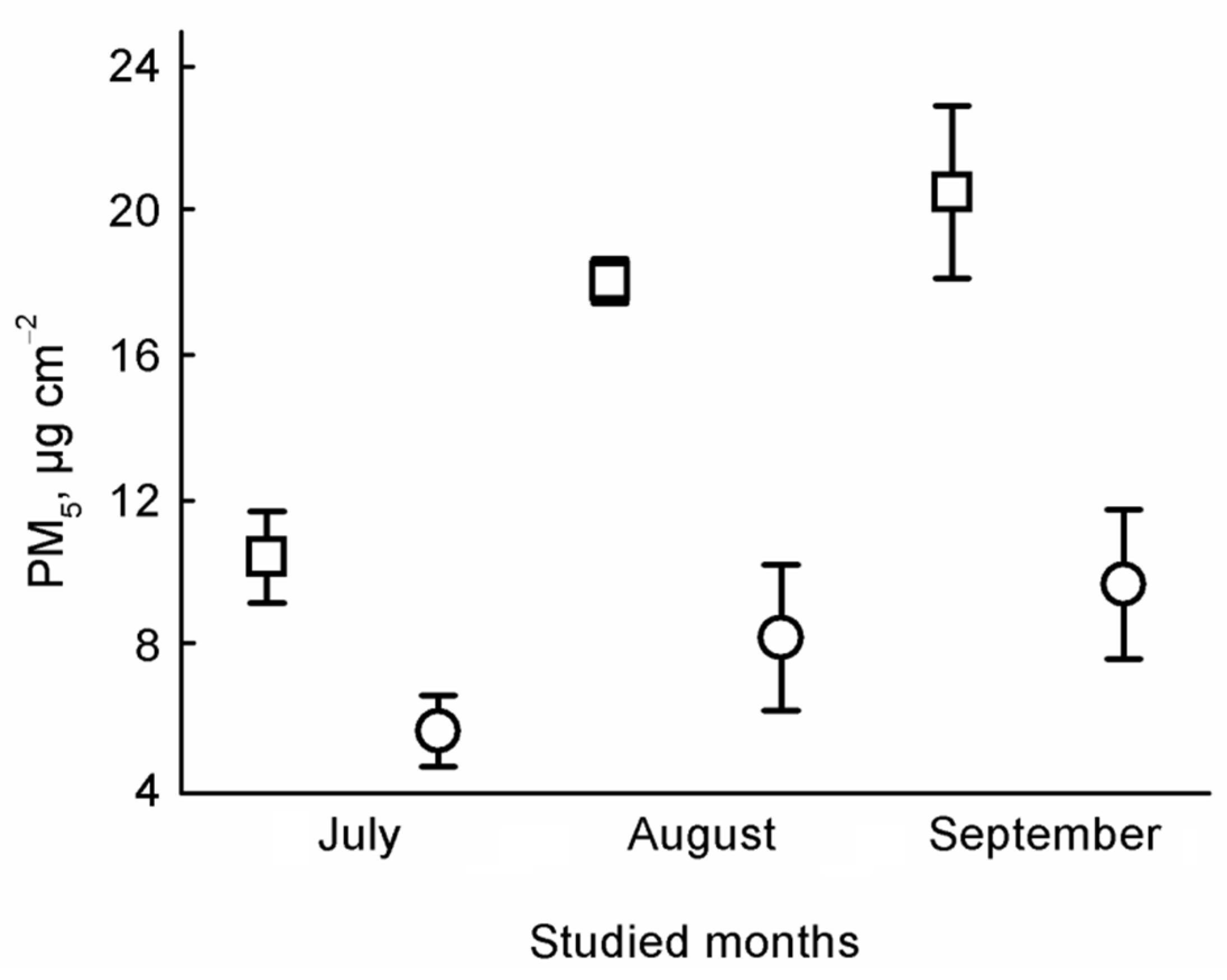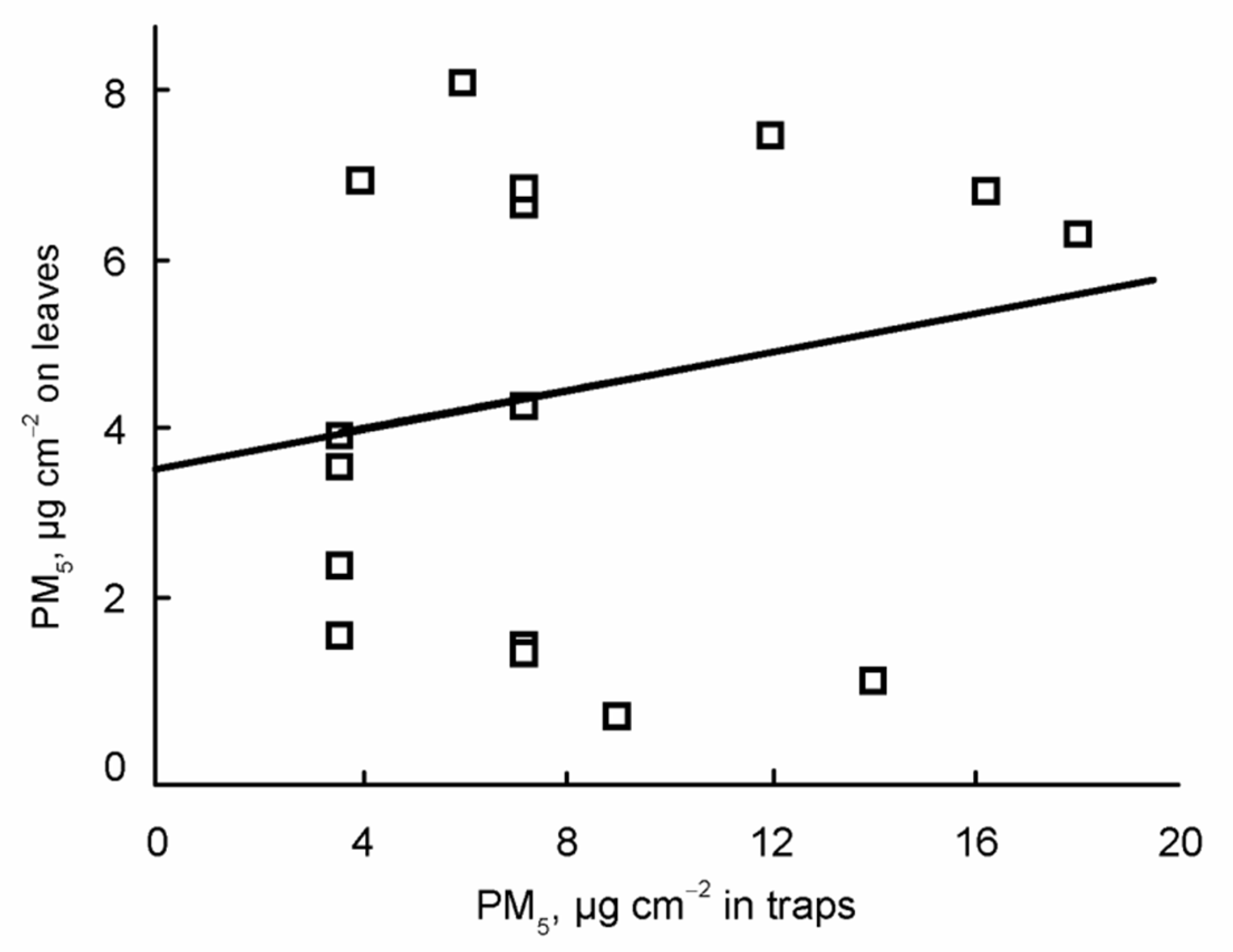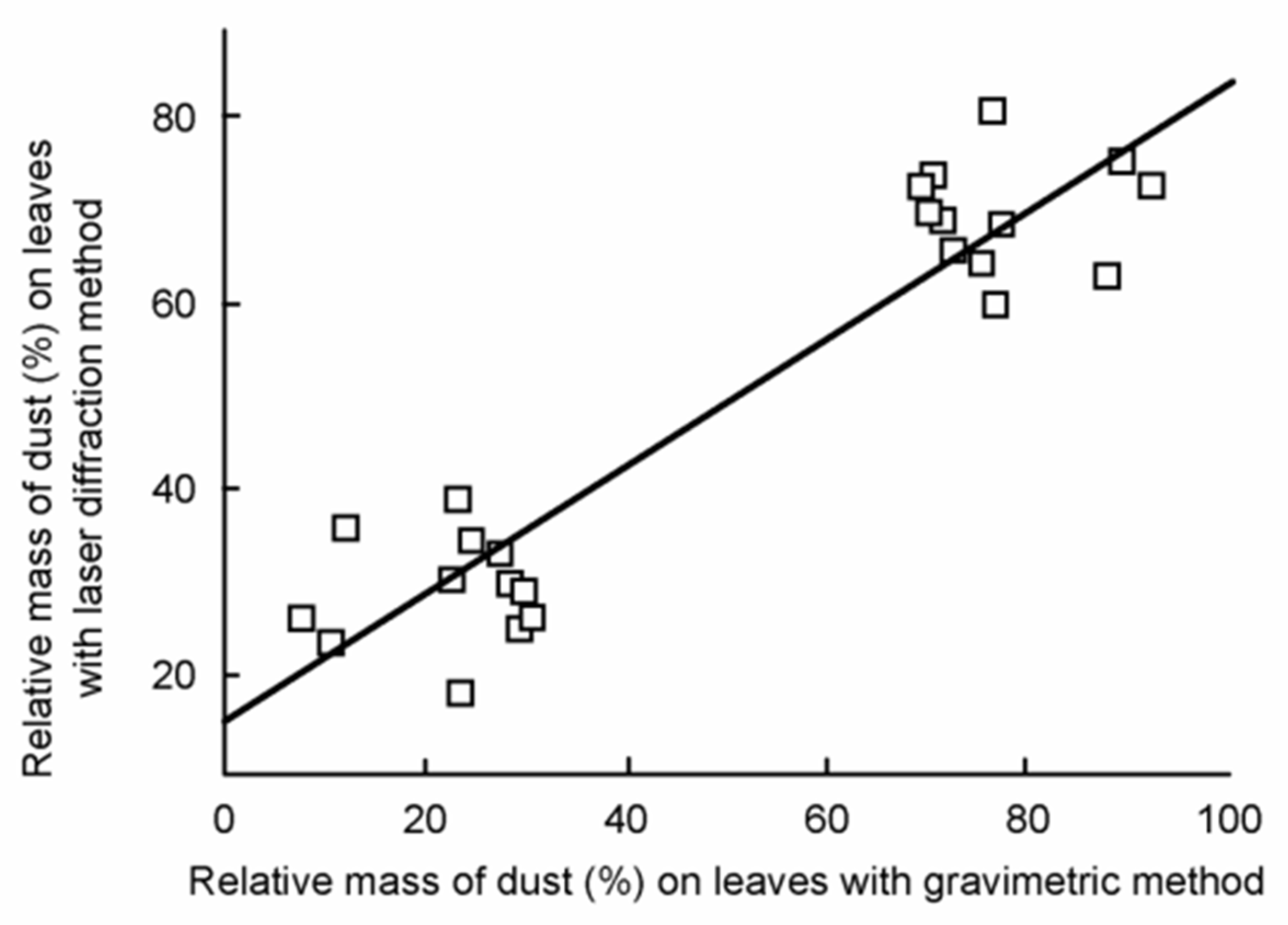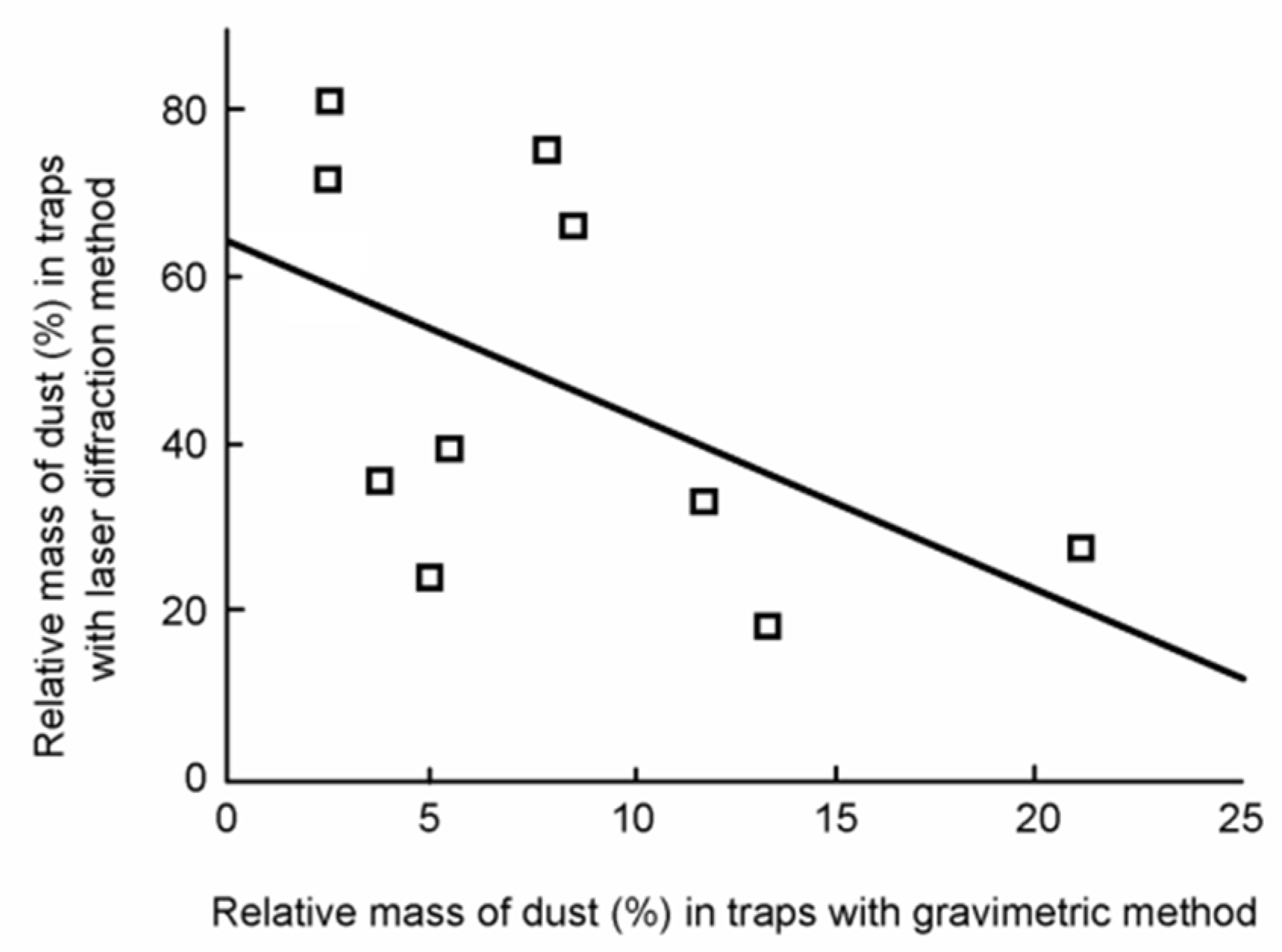Ecological Assessment of Particulate Material (PM5 and PM10) in Urban Habitats
Abstract
1. Introduction
2. Experiments
3. Results
4. Discussion
5. Conclusions
Author Contributions
Funding
Conflicts of Interest
References
- Ayres, J.; Maynard, E.L.; Richards, R. (Eds.) Air Pollution and Health, 1st ed.; Imperial College Press: London, UK, 2006; ISBN 9781860941917. [Google Scholar]
- Seinfeld, J.H.; Pandis, S. Atmospheric Chemistry and Physics: From Air Pollution to Climate Change, 2nd ed.; Wiley-Interscience: New Jersey, NJ, USA, 2006. [Google Scholar]
- Cai, M.; Xin, Z.; Yu, X. Spatio-temporal variations in PM leaf deposition: A meta-analysis. Environ. Pollut. 2017, 231, 207–218. [Google Scholar] [CrossRef] [PubMed]
- Notardonato, I.; Manigrasso, M.; Pierno, L.; Settimo, G.; Protano, C.; Vitali, M.; Mattei, V.; Martellucci, S.; Fiore, C.D.; Boccia, P.; et al. The importance of measuring ultrafine particles in urban air quality monitoring in small cities. Geogr. Pannonica 2019, 23, 347–358. [Google Scholar] [CrossRef]
- Molnár, V.É.; Simon, E.; Tóthmérész, B.; Ninsawat, S.; Szabó, S. Air pollution induced vegetation stress—The Air Pollution Tolerance Index as a quick tool for city health evaluation. Ecol. Indic. 2020, 113, 106234. [Google Scholar] [CrossRef]
- Varga, G.; Roettig, C.B. Identification of Saharan dust particles in Pleistocene dune sand-paleosol sequences of fuerteventura (Canary Islands). Hung. Geogr. Bull. 2018, 67, 121–141. [Google Scholar] [CrossRef]
- Querol, X.; Tobías, A.; Pérez, N.; Karanasiou, A.; Amato, F.; Stafoggia, M.; Pérez García-Pando, C.; Ginoux, P.; Forastiere, F.; Gumy, S.; et al. Monitoring the impact of desert dust outbreaks for air quality for health studies. Environ. Int. 2019, 130, 104867. [Google Scholar] [CrossRef]
- Lonati, G.; Giugliano, M. Size distribution of atmospheric particulate matter at traffic exposed sites in the urban area of Milan (Italy). Atmos. Environ. 2006, 40, 264–274. [Google Scholar] [CrossRef]
- Pant, P.; Harrison, R.M. Estimation of the contribution of road traffic emissions to particulate matter concentrations from field measurements: A review. Atmos. Environ. 2013, 77, 78–97. [Google Scholar] [CrossRef]
- Jia, Y.Y.; Wang, Q.; Liu, T. Toxicity research of PM2.5 compositions in vitro. Int. J. Environ. Res. Public Health 2017, 14, 232. [Google Scholar] [CrossRef]
- Borsy, Z.Z. Blown sand territories in Hungary. Geomorphology 1991, 90, 1–14. [Google Scholar]
- Kiss, T.; Lóki, J. Parabolic dunes of the Southern Nyírség. In Landscapes and Landforms of Hungary; Lóczy, D., Ed.; Springer: Dordrecht, Hollandia, 2015; pp. 263–271. ISBN 978-3-319-08997-3. [Google Scholar]
- Szoboszlai, Z.; Kertész, Z.; Szikszai, Z.; Borbély-Kiss, I.; Koltay, E. Ion beam microanalysis of individual aerosol particles originating from Saharan dust episodes observed in Debrecen, Hungary. Nucl. Instrum. Methods Phys. Res. Sect. B Beam Interact. Mater. Atoms 2009, 267, 2241–2244. [Google Scholar] [CrossRef]
- Pongrácz, R.; Bartholy, J.; Kis, A. Estimation of future precipitation conditions for Hungary with special focus on dry periods. Idojaras 2014, 118, 305–321. [Google Scholar]
- Spinoni, J.; Szalai, S.; Szentimrey, T.; Lakatos, M.; Bihari, Z.; Nagy, A.; Németh, Á.; Kovács, T.; Mihic, D.; Dacic, M.; et al. Climate of the Carpathian Region in the period 1961–2010: Climatologies and trends of 10 variables. Int. J. Climatol. 2014, 35, 1322–1341. [Google Scholar] [CrossRef]
- Achakulwisut, P.; Anenberg, S.C.; Neumann, J.E.; Penn, S.L.; Weiss, N.; Crimmins, A.; Fann, N.; Martinich, J.; Roman, H.; Mickley, L.J. Effects of Increasing Aridity on Ambient Dust and Public Health in the U.S. Southwest Under Climate Change. GeoHealth 2019, 3, 127–144. [Google Scholar] [CrossRef]
- Huang, J.; Wang, T.; Wang, W.; Li, Z.; Yan, H. Climate effects of dust aerosols over East Asian arid and semiarid regions Jianping. J. Geophys. Res. Atmos. 2014, 119, 1–19. [Google Scholar] [CrossRef]
- Négyesi, G.; Lóki, J.; Buró, B.; Bertalan-Balázs, B.; Pásztor, L. Wind erosion researches in hungary – past, present and future possibilities. Hung. Geogr. Bull. 2019, 68, 223–240. [Google Scholar] [CrossRef]
- Pásztor, L.; Négyesi, G.; Laborczi, A.; Kovács, T.; László, E.; Bihari, Z. Integrated spatial assessment of wind erosion risk in Hungary. Nat. Hazards Earth Syst. Sci. 2016, 16, 2421–2432. [Google Scholar] [CrossRef]
- Qiang, M.; Lang, L.; Wang, Z. Do fine-grained components of loess indicate westerlies: Insights from observations of dust storm deposits at Lenghu (Qaidam Basin, China). J. Arid Environ. 2010, 74, 1232–1239. [Google Scholar] [CrossRef]
- Friese, C.A.; van der Does, M.; Merkel, U.; Iversen, M.H.; Fischer, G.; Stuut, J.B.W. Environmental factors controlling the seasonal variability in particle size distribution of modern Saharan dust deposited off Cape Blanc. Aeolian Res. 2016, 22, 165–179. [Google Scholar] [CrossRef]
- Simon, E.; Braun, M.; Vidic, A.; Bogyó, D.; Fábián, I.; Tóthmérész, B. Air pollution assessment based on elemental concentration of leaves tissue and foliage dust along an urbanization gradient in Vienna. Environ. Pollut. 2011, 159, 1229–1233. [Google Scholar] [CrossRef]
- Braun, M.; Margitai, Z.; Leermakers, A.T.B. Martine Environmental Monitoring Using Linden Tree Leaves As Natural Traps of Atmospheric Deposition: A Pilot Study in Transilvania, Romania. AGD Landsc. Environ. 2007, 1, 24–35. [Google Scholar]
- Allajbeu, S.; Qarri, F.; Marku, E.; Bekteshi, L.; Ibro, V.; Frontasyeva, M.V.; Stafilov, T.; Lazo, P. Contamination scale of atmospheric deposition for assessing air quality in Albania evaluated from most toxic heavy metal and moss biomonitoring. Air Qual. Atmos. Heal. 2017, 10, 587–599. [Google Scholar] [CrossRef]
- Margitai, Z.; Simon, E.; Fábián, I.; Braun, M. Inorganic chemical composition of dust deposited on oleander (Nerium oleander L.) leaves. Air Qual. Atmos. Health 2017, 10, 339–347. [Google Scholar] [CrossRef][Green Version]
- Simon, E.; Baranyai, E.; Braun, M.; Cserháti, C.; Fábián, I.; Tóthmérész, B. Elemental concentrations in deposited dust on leaves along an urbanization gradient. Sci. Total Environ. 2014, 490, 514–520. [Google Scholar] [CrossRef] [PubMed]
- Baranyai, E.; Simon, E.; Braun, M.; Tóthmérész, B.; Posta, J.; Fábián, I. The effect of a fireworks event on the amount and elemental concentration of deposited dust collected in the city of Debrecen, Hungary. Air Qual. Atmos. Heal. 2015, 8, 359–365. [Google Scholar] [CrossRef] [PubMed]
- Burkhardt, J.; Pariyar, S. Particulate pollutants are capable to “degrade” epicuticular waxes and to decrease the drought tolerance of Scots pine (Pinus sylvestris L.). Environ. Pollut. 2014, 184, 659–667. [Google Scholar] [CrossRef] [PubMed]
- Gajbhiye, T.; Pandey, S.K.; Lee, S.S.; Kim, K.H. Size fractionated phytomonitoring of airborne particulate matter (PM)and speciation of PM bound toxic metals pollution through Calotropis procera in an urban environment. Ecol. Indic. 2019, 104, 32–40. [Google Scholar] [CrossRef]
- Chaudhary, I.J.; Rathore, D. Dust pollution: Its removal and effect on foliage physiology of urban trees. Sustain. Cities Soc. 2019, 51, 101696. [Google Scholar] [CrossRef]
- Schleicher, N.J.; Norra, S.; Chai, F.; Chen, Y.; Wang, S.; Cen, K.; Yu, Y.; Stüben, D. Temporal variability of trace metal mobility of urban particulate matter from Beijing—A contribution to health impact assessments of aerosols. Atmos. Environ. 2011, 45, 7248–7265. [Google Scholar] [CrossRef]
- Pásztor, L.; Laborczi, A.; Takács, K.; Szatmári, G.; Illés, G.; Fodor, N.; Négyesi, G.; Bakacsi, Z.; Szabó, J. Spatial distribution of selected soil features in Hajdú-Bihar county represented by digital soil maps. Landsc. Environ. 2016, 10, 203–213. [Google Scholar] [CrossRef]
- Lázár, I.; Csákberényi-Nagy, G.; Túri, Z.; Kapocska, L.; Tóth, T.; Barnabás Tóth, J. Analysis of Factors Affecting Wind-Energy Potential in Low Built-Up Urban Environments. In Proceedings of the Air and Water Components of the Environment, Cluj-Napoca, Romania, 21–22 March 2014; Pandi, G., Moldovan, F., Eds.; Babes-Bolyai University: Cluj-Napoca, Romania, 2014; pp. 369–376. [Google Scholar]
- Négyesi, G.; Lóki, J.; Buró, B.; Szabó, S. Effect of soil parameters on the threshold wind velocity and maximum eroded mass in a dry environment. Arab. J. Geosci. 2016, 9, 588. [Google Scholar] [CrossRef]
- Air Quality Automatic Measure in Hungary. Available online: http://www.levegominoseg.hu/automata-merohalozat?AspxAutoDetectCookieSupport=1 (accessed on 30 April 2020).
- Environment Air Quality Standards in the European Commission. Available online: https://ec.europa.eu/environment/air/quality/standards.htm (accessed on 30 April 2020).
- Varga, G. Changing nature of Saharan dust deposition in the Carpathian Basin (Central Europe): 40 years of identified North African dust events (1979–2018). Environ. Int. 2020, 139, 105712. [Google Scholar] [CrossRef] [PubMed]
- Marques de Sá, J. Applied Statistics Using SPSS, STATISTICA, MATLAB and R., 2nd ed.; Springer: Porto, Portugal, 2007; ISBN 978-3-540-71971-7. [Google Scholar]
- Bengtsson, R. Variation in common lime(Tilia x europaea L.) in Swedish Gardensof the 17th and 18th centuries. Acta Univ. Agric. Suec. 2005, 2005, 64–106. [Google Scholar]
- Cekstere, G.; Osvalde, A. A study of chemical characteristics of soil in relation to street trees status in Riga (Latvia). Urban For. Urban Green. 2013, 12, 69–78. [Google Scholar] [CrossRef]
- Ţenche-Constantinescu, A.M.; Madoşa, E.; Chira, D.; Hernea, C.; Ţenche-Constantinescu, R.V.; Lalescu, D.; Borlea, G.H. Tilia spp.-Urban Trees for Future. Not Bot Horti Agrobot. 2015, 43, 259–264. [Google Scholar] [CrossRef]
- Bottalico, F.; Chirici, G.; Giannetti, F.; De Marco, A.; Nocentini, S.; Paoletti, E.; Salbitano, F.; Sanesi, G.; Serenelli, C.; Travaglini, D. Air Pollution Removal by Green Infrastructures and Urban Forests in the City of Florence. Agric. Agric. Sci. Procedia 2016, 8, 243–251. [Google Scholar] [CrossRef]
- Przybysz, A.; Sæbø, A.; Hanslin, H.M.; Gawroński, S.W. Accumulation of particulate matter and trace elements on vegetation as affected by pollution level, rainfall and the passage of time. Sci. Total Environ. 2014, 481, 360–369. [Google Scholar] [CrossRef]
- Song, Y.; Maher, B.A.; Li, F.; Wang, X.; Sun, X.; Zhang, H. Particulate matter deposited on leaf of five evergreen species in Beijing, China: Source identification and size distribution. Atmos. Environ. 2015, 105, 53–60. [Google Scholar] [CrossRef]
- Yan, J.; Lin, L.; Zhou, W.; Han, L.; Ma, K. Quantifying the characteristics of particulate matters captured by urban plants using an automatic approach. J. Environ. Sci. 2016, 39, 259–267. [Google Scholar] [CrossRef]
- Hwang, H.J.; Yook, S.J.; Ahn, K.H. Experimental investigation of submicron and ultrafine soot particle removal by tree leaves. Atmos. Environ. 2011, 45, 6987–6994. [Google Scholar] [CrossRef]
- Sgrigna, G.; Sæbø, A.; Gawronski, S.; Popek, R.; Calfapietra, C. Particulate Matter deposition on Quercus ilex leaves in an industrial city of central Italy. Environ. Pollut. 2015, 197, 187–194. [Google Scholar] [CrossRef]
- Mo, L.; Ma, Z.; Xu, Y.; Sun, F.; Lun, X.; Liu, X.; Chen, J.; Yu, X. Assessing the capacity of plant species to accumulate particulate matter in Beijing, China. PLoS ONE 2015, 10, 1–18. [Google Scholar] [CrossRef] [PubMed]
- Blanusa, T.; Fantozzi, F.; Monaci, F.; Bargagli, R. Leaf trapping and retention of particles by holm oak and other common tree species in Mediterranean urban environments. Urban. For. Urban. Green. 2015, 14, 1095–1101. [Google Scholar] [CrossRef]
- Tallis, M.; Taylor, G.; Sinnett, D.; Freer-Smith, P. Estimating the removal of atmospheric particulate pollution by the urban tree canopy of London, under current and future environments. Landsc. Urban Plan. 2011, 103, 129–138. [Google Scholar] [CrossRef]
- Rai, P.K.; Panda, L.L.S. Leaf dust deposition and its impact on Biochemical aspect of some Roadside. Int. Res. J. Environ. Sci. 2014, 3, 14–19. [Google Scholar]
- Prusty, B.A.K.; Mishra, P.C.; Azeez, P.A. Dust accumulation and leaf pigment content in vegetation near the national highway at Sambalpur, Orissa, India. Ecotoxicol. Environ. Saf. 2005, 60, 228–235. [Google Scholar] [CrossRef] [PubMed]
- Shin, S.E.; Jung, C.H.; Kim, Y.P. Analysis of the measurement difference for the PM 10 concentrations between beta-ray absorption and gravimetric methods at gosan. Aerosol Air Qual. Res. 2011, 11, 846–853. [Google Scholar] [CrossRef]
- Gebicki, J.; Szymańska, K. Comparative field test for measurement of PM10 dust in atmospheric air using gravimetric (reference) method and β-absorption method (Eberline FH 62-1). Atmos. Environ. 2012, 54, 18–24. [Google Scholar] [CrossRef]
- Tasić, V.; Jovašević-Stojanović, M.; Vardoulakis, S.; Milošević, N.; Kovačević, R.; Petrović, J. Comparative assessment of a real-time particle monitor against the reference gravimetric method for PM 10 and PM 2.5 in indoor air. Atmos. Environ. 2012, 54, 358–364. [Google Scholar] [CrossRef]
- Song, Y.; Zhang, M.; Cai, X. PM10 modeling of Beijing in the winter. Atmos. Environ. 2006, 40, 4126–4136. [Google Scholar] [CrossRef]
- Srimuruganandam, B.; Shiva Nagendra, S.M. Application of positive matrix factorization in characterization of PM10 and PM2.5 emission sources at urban roadside. Chemosphere 2012, 88, 120–130. [Google Scholar] [CrossRef]
- Andreychouk, V. (Ed.) Dissertation Comissions of Cultural Landscape: Methods of Landscape Research; Polish Academy of Sciences Institute of Geography and Spatial Organization, Polish Geographical Society: Sosnowiec, Poland, 2008; pp. 113–126. [Google Scholar]







© 2020 by the authors. Licensee MDPI, Basel, Switzerland. This article is an open access article distributed under the terms and conditions of the Creative Commons Attribution (CC BY) license (http://creativecommons.org/licenses/by/4.0/).
Share and Cite
Simon, E.; Molnár, V.É.; Tóthmérész, B.; Szabó, S. Ecological Assessment of Particulate Material (PM5 and PM10) in Urban Habitats. Atmosphere 2020, 11, 559. https://doi.org/10.3390/atmos11060559
Simon E, Molnár VÉ, Tóthmérész B, Szabó S. Ecological Assessment of Particulate Material (PM5 and PM10) in Urban Habitats. Atmosphere. 2020; 11(6):559. https://doi.org/10.3390/atmos11060559
Chicago/Turabian StyleSimon, Edina, Vanda Éva Molnár, Béla Tóthmérész, and Szilárd Szabó. 2020. "Ecological Assessment of Particulate Material (PM5 and PM10) in Urban Habitats" Atmosphere 11, no. 6: 559. https://doi.org/10.3390/atmos11060559
APA StyleSimon, E., Molnár, V. É., Tóthmérész, B., & Szabó, S. (2020). Ecological Assessment of Particulate Material (PM5 and PM10) in Urban Habitats. Atmosphere, 11(6), 559. https://doi.org/10.3390/atmos11060559





